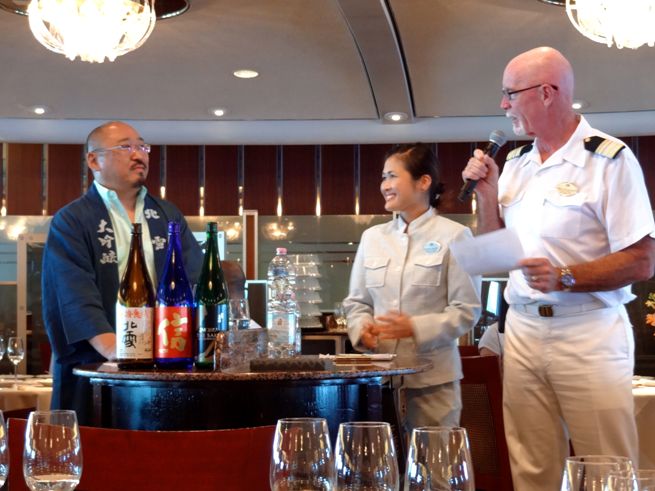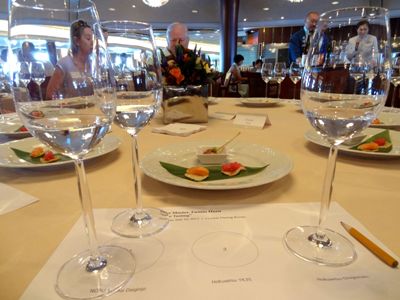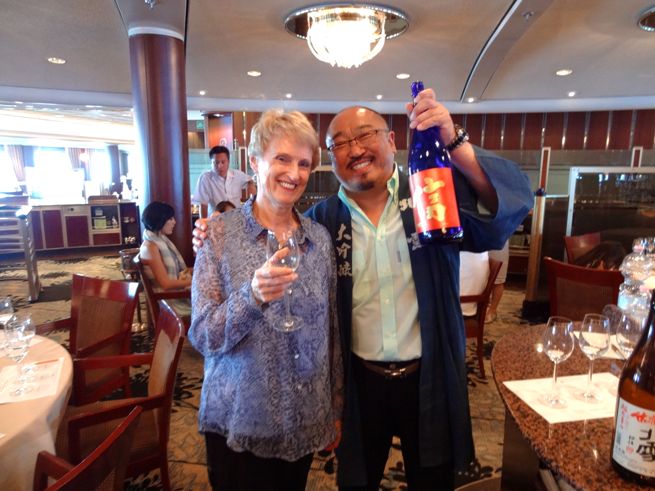































A SAKE EDUCATION
|
Like brewing a superior beer or developing a prize winning wine, making an excellent sake has its own special requirements. Mr. Fumio Hazu, CEO of the Hokusetsu Brewery in Japan, led us on an educational experience to learn about the art of sake production.
In order to make great sake, you must have fine water and fine sake rice, as well as the right yeast, the technical skill of the brewers and local weather conditions suitable for production.
Once the sake rice has been harvested, it is steam cooked and then mixed with yeast and koji, which is rice cultivated with a mold. The mixture ferments with more rice, koji, and water added to it in three batches over the course of four days. The fermentation takes place in a large tank, and the conditions inside each tank are different.
 After the mash has fermented for 18 to 32 days, it is pressed, filtered and blended. Although most of the pressing is now done by a machine, almost all breweries still press some of their best sake in the old way with a special, more labor intensive operation.
After the mash has fermented for 18 to 32 days, it is pressed, filtered and blended. Although most of the pressing is now done by a machine, almost all breweries still press some of their best sake in the old way with a special, more labor intensive operation.
Another major advance is the use of ceramic-lined or stainless steel tanks instead of the cedar tanks which were used for hundreds of years.
Once we understood the process, it was time to taste the product. Having always been served warm sake in Japanese restaurants, I was surprised to learn that there are different levels of smoothness and aroma. All of the sake we tasted was at room temperature and began with an earthy flavored sample, which was not very smooth tasting. The second glass was a more delicate, smooth, enjoyable choice. But, the clear winner was bottle number 3, a Hokusetsu YK35. It was easily the group favorite and also turned out to be the most expensive. Each sake drink was matched with an appropriate bite sized food pairing.
What would your beverage choice be: wine, beer or sake?
* The sake tasting is part of Crystal Cruises’ Food and Wine Adventures on the Crystal Symphony and features on board presentations by the world famed chef, Nobu Matsuhisa.


 "Flying high over the peaks of Alaska in our 6 passenger plane to Punchbowl Glacier was thrilling. Once on the ground, we boarded our dog sled for an exciting race across the glacier pulled by our team of eager, trained dogs – thinking the Iditarod! And who didn’t love playing with the 3 little future Iditarod puppies afterwards?! It was a wonderful way to enjoy Alaska on our cruise, and we all loved it. Thanks again for a wonderful vacation that was perfect for all ages in our family group." Ann & Steve
"Flying high over the peaks of Alaska in our 6 passenger plane to Punchbowl Glacier was thrilling. Once on the ground, we boarded our dog sled for an exciting race across the glacier pulled by our team of eager, trained dogs – thinking the Iditarod! And who didn’t love playing with the 3 little future Iditarod puppies afterwards?! It was a wonderful way to enjoy Alaska on our cruise, and we all loved it. Thanks again for a wonderful vacation that was perfect for all ages in our family group." Ann & Steve